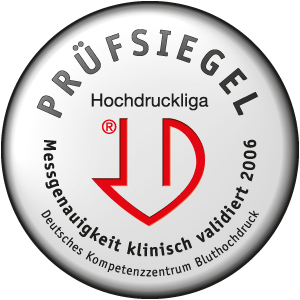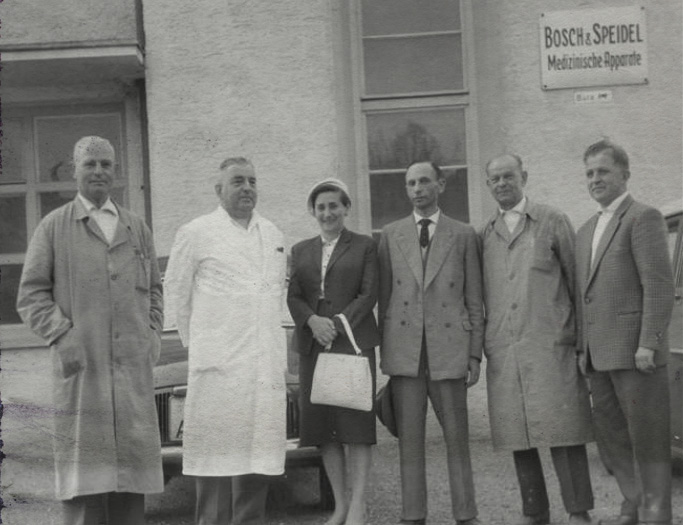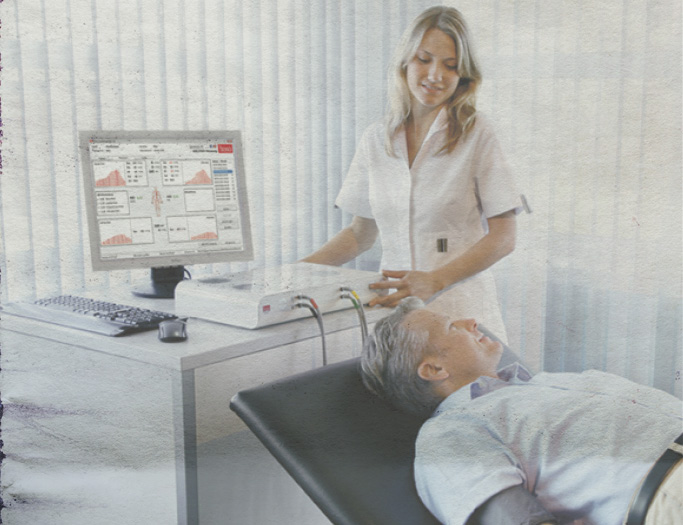Health is a matter of trust.
blood pressure
monitoring
is boso.
boso medicus X
The best upper arm blood pressure monitor
Stiftung Warentest 5/2016, 11/2018 and 9/2020
boso is the brand with which 96% of all German general practitioners, physicians and internists work in practice. This makes your equipment purchase very easy: Security guaranteed with boso. Simply choose the type of device that best suits your personal needs.
seal:
ESH-test report confirms highest quality of boso.
All digital boso self-measuring devices have passed the criteria of the German Hypertension League or the rigorous test protocol of the European Society of Hypertension (ESH).


news:
boso TM-2450 with the extension for the determination of the central blood pressure!
From boso for you: General information on blood pressure and measurement.
What is blood pressure?
The measurement of blood pressure is one of the most important tools in the repertoire of GPs. But it is also extremely important for patients at home to check their own measurements regularly. Not only when they are taking medicine. In particular for older people and people who are health-conscious, measuring your own blood pressure daily should be a matter of course. This is because it allows early recognition of changes that suggest a deterioration of vital functions or an illness.
The blood vessels of the body form a widely interlinked, flexible system through which all the blood in the body flows. Blood is pumped into the circulation of the body by the heart, thereby providing all organs with blood rich in oxygen and nutrients.
The blood pressure is the arterial pressure measured in the vessels and chambers of the heart. The measurement of the blood pressure therefore gives information about the pressure in the arterial circulation and is therefore one of the most important diagnostic tools in the repertoire of GPs. The blood pressure is thus dependent on the performance of the heart and the resistance of the vessels. It is measured in mmHg (mm of mercury column). Two values must be calculated here: The systolic (upper) blood pressure is created when the heart contracts and the blood is pressed into the blood vessels. The diastolic (lower) blood pressure is created when the heart muscle is extended and refilling itself with blood.
What is high blood pressure?
One refers to high blood pressure or (arterial) hypertension if there is a sustained pressure of 140 mmHg (systolic) and/or 90 mmHG (diastolic). Many people are unaware that approximately 25% of the adult population and around half the over-60s suffer from high blood pressure. High blood pressure can exist for many years without causing any problems. However, the consequence can be serious illnesses, since in the long-term various organs such as the heart, brain, blood vessels and kidneys are damaged.
Regular blood pressure measurements have therefore acquired a high level of significance in our society and in addition to blood pressure measurement in GP surgeries, daily self-measurement of blood pressure at home has also become common. This is because only regular checks can prevent damage or circulation disorders, or recognise them soon enough to enable treatment with medication to be started, for example. In particular, people in the so-called risk groups should take their blood pressure regularly as a matter of course. Particular risk factors include e.g. inherited high blood pressure, age, overweight, diabetes, kidney diseases, stress and food rich in salt.
What should one consider under the heading of health care?
Measure and check your blood pressure regularly - with self-measurement devices you can also do this very easily and simply at home. In this way, you receive precise and reliable information on your health status within a few minutes. If you notice that your blood pressure is too high or you see other signs of illness, you should consult your doctor without fail.
However, a healthy diet is also always important for your health. Regular exercise and relaxation are further factors that you can use to contribute positively to your health. And note the special risk factors for high blood pressure, such as e.g. inherited high blood pressure, age, overweight, diabetes, kidney diseases, stress and food rich in salt.
What is your device type?
Take advice from your doctor or from professional suppliers, i.e. chemists or medical supply stores. This is because patients who measure their blood pressure themselves should be given extensive instructions. Would you like help in assessing your blood pressure values and additional useful information? Are you perhaps measuring jointly with another person, or would you like an assessment on your smartphone or computer? Do you have an irregular heartbeat or do you need a larger cuff? There is a wide choice of different device types because accurate blood pressure measurement relies on using a device that is optimally suited to the needs of the individual. Only self-measurement that has been correctly carried out offers an excellent means of therapy control.
Some basic information for your first steps:
For self-measurement, a distinction is generally made between upper arm and wrist measurement. Both measurement methods can be considered of equal value. However, it is recommended that people with narrowed blood vessels, which is often the case for older people, should use an upper arm device, since wrist devices can under certain circumstances give imprecise measurements.
The most common self-measurement devices are entirely automatic, so that one only needs to press a button to start the measurement. The devices pump up independently - most simultaneously already calculating the high (systolic) value, so that the measurement is a very soft and pleasant process - and then automatically release the air again. At the end, systolic, diastolic and pulse measurements can be easily read on the display.
There are also devices which are particularly suitable in the case of irregular heartbeat, for example, like the classic model with built-in stethoscope - the measurement method that is often also used by doctors.
To the classic devices with stethoscope
By the way: All the measurement methods mentioned have no impact on any pacemaker. However, to verify the measurement results, comparable measurements by a doctor are recommended.
In addition to the device type, the correct cuff is one of the most important aspects for precise blood pressure measurement. So be careful to have the correct cuff size for either the upper arm or the wrist, since otherwise erroneous measurements may occur. We have an extensive choice of cuff sizes, particularly for upper arm devices, with the following choices for boso devices:
Arm circumference 16 - 22 cm - XS-cuff | 22 – 32 cm = standard cuff22 – 42 cm = universal cuff | 32 – 48 cm = XL cuff
What do you need to look out for during blood pressure measurement?
On which arm should the measurement be taken?
How do you put on the cuff?
Why do blood pressure measurements sometimes vary?
And how should I evaluate the measurements?
In our "Blood pressure measurement: the basics" leaflet,
we have summarized the most important information for
you, briefly and succinctly – click here to download
History
Efficiency + progress is our tradition

1889 - 1905
1889 Foundation of J. & A. Bosch in Strasbourg (by the swabian mechanics Josef and Albert Bosch). Specialization in scientific devices.
Shortly after its foundation, the company's seismic devices received a gold medal at the world exhibitions in Paris (1900) and St. Louis (1904).
Another breakthrough came at the beginning of 1900 with a blood pressure monitor that could be mass-produced.
1905 The first oscillometric blood pressure monitor is developed.

1918 - 1920
The end of J. & A. Bosch is sealed by the loss of the First World War. Albert Bosch was allowed to temporarily manage the company from 1918, but it was liquidated in 1920.
Albert Bosch returns to Jungingen and tries to enter his parents' business. The owners at the time, his brothers, refused to let him in. For financial reasons, Albert Bosch looks for a partner and finds him in Albert Speidel from Jungingen.

1922 - 1964
1922 New foundation as BOSCH & SPEIDEL in Jungingen (by Albert Bosch and Albert Speidel). Specialization in mechanical blood pressure monitors. The first blood pressure self-monitoring device with stethoscope is developed.
1925 Willi Bosch and Carl Keller join Bosch & Speidel.
1949 Introduction of the oscillograph, a recording device for non-invasive vascular diagnostics. In this decades, Bosch & Speidel achieve a worldwide reputation in the manufacture of blood pressure monitors.

1965 - 1976
1965 BOSCH & SPEIDEL splits into two companies: SPEIDEL+KELLER und BOSCH+SOHN – boso.
1968 The "bosophon" is the first electronic blood pressure monitor from boso to be launched on the market.
1971 boso moves to the former Riester sawmill (present day old building).
1976 Kurt Rädle joins the company as the commercial manager. The first electronic self-measuring device and the oscillometric measuring method are introduced by boso in Germany.

1977 - 1996
1977 boso receives the "European Quality Award" for electronic blood pressure monitors.
1980 The "boso digital" as the first digital blood pressure monitor for home use is approved.
1990 Management buy-out by Mr. Kurt Rädle.
1991 Introduction of the 24-hour blood pressure monitor "TM-2420".
1995 Certification according to the standards ISO 9001 and ISO 13485.
1996 The 24-hour blood pressure monitor "TM-2430" comes onto the market.

2002 - 2009
2002 The first boso upper arm device receives the seal of the “German Hypertension League”, further devices to follow.
2005 All mechanical blood pressure monitors from boso are “shock protected”.
2007 "ABI-system 100" for PAOD screening and Mercurius E are launched.
2008 boso is two times the test winner from Stiftung Warentest with the devices "boso medicus family" (upper arm) and "boso medistar s" (wrist).
2009 "ABI-system 100" is clinically validated and is registered as a patent.

2012 - 2024
2012 The "boso ABI-system 100" with PWV (Pulse Wave Velocity, measurement for assessing arterial stiffness) is introduced.
2013 The first digital blood pressure monitor is validated according to the ESH protocol.
2016 "boso medicus X" is the test winner of Stiftung Warentest 05/2016. 96% of all German general practitioners and internists use blood pressure monitors in their practices from boso (API study by GfK, 01/2016).
2017 All boso blood pressure monitors are classified by DEKRA Certification GmbH according to MDD (Medical Device Directive).
2018 "boso medicus X" is again the test winner of Stiftung Warentest 11/2018.
2020 "boso medicus X" continues to be named the best upper arm blood pressure monitor in the test of Stiftung Warentest 09/2020.
2021 The new generation of the 24-hour ambulatory blood pressure monitor TM-2450 (optional with cBP, central Blood Pressure) is introduced, boso prepares all of its products for classification in accordance with the MDR (Medical Devices Regulation) by DEKRA Certification GmbH.
